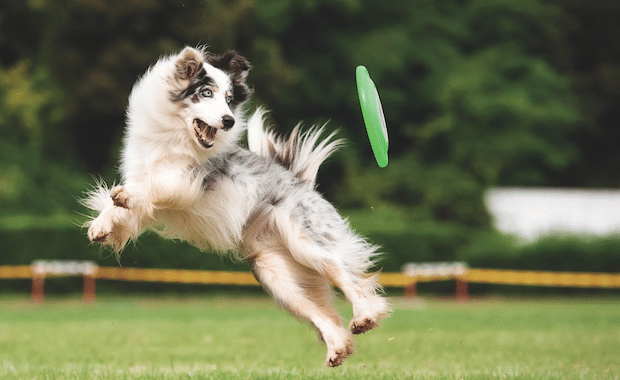Editor’s note: Have you seen the new Dogster print magazine in stores? Or in the waiting room of your vet’s office? This article appeared in our August-September issue. Subscribe to Dogster and get the bimonthly magazine delivered to your home.
I have three dogs. One of them, a big mixed breed named Monster, loves to fetch. I didn’t even have to teach him — the first time he saw a ball, he put it in his mouth, then dropped it at my feet. I picked it up, threw it, and he enthusiastically fetched it and brought it right back. He will fetch anywhere and all day long.
I also have two very serious working Border Collies, Echo and Radar, who were rescued from a neglectful situation as 8-week-old puppies. They’re shy — until you get them around sheep. They’re 11 years old now and help me on our Colorado farm.
However, they’ve never fetched a ball in their lives. It’s not that I haven’t tried to teach them; they just see no rational reason to fetch a ball and bring it back to me only to have me throw it again.
I’m OK with them being uninterested in fetching; we have lots of land for them to run on. But many dog owners live in cities and want their dogs to fetch — it’s a great way to get exercise, and it can be done safely in your own backyard.

I don’t advocate making dogs do something they find uninteresting (I’m not talking about obedience and good manners, of course). But a game of fetch isn’t a bad thing to want to teach your dog.
Here’s how I taught Echo to enjoy fetching:
1. I found a cat toy that had feathers attached to the end of a thin, springy pole. I showed it to Echo and made a huge deal about the feathers. First, I put the toy on the ground and let Echo sniff and explore it. I picked it up and put it back down, but this time I put small pieces of cooked chicken under the feathers. Echo can be shy with new objects, so I wanted her to feel confident in exploring and seeking the chicken under the feathers. It worked!
2. Next, I put down a second feather stick and put chicken under that one, too. Echo felt braver and went to explore it. As she did, I ran to the other feather stick and placed chicken under that one. She began to get the idea and started trotting back and forth between them.
3. I began to verbally encourage Echo to really run between the two sticks. Once I had that motion from her, I surprised her and picked up the stick I ran toward and called her to keep running after the stick I was dragging. She did! I did these three steps in short sessions for a few days in a row. Her eyes got wide, and her body language expressed delight just at seeing the feather sticks.
4. It’s hard to toss a slim stick with fake feathers at the end of it — and it would be awkward for a dog to pick up and carry — so I slowly made a switch after Echo was really excited about the feather stick. I glued string onto a tennis ball and began the process anew, although I placed the ball next to the feather stick on the ground with some chicken under it. I ran across the room to a second tennis ball I had placed with chicken also under and next to a feather stick. Echo followed me at a trot, went to the ball, pushed it aside, and gobbled up the chicken.
5. After I got Echo used to the tennis ball, I got her revved up to run back and forth between each ball on the ground and then, just as I did before with the feather stick, I tugged on the tennis ball via the string I had glued to it. Echo followed it! When she picked it up in her mouth, I praised her. Then I ran away from her, hoping she’d still hold the ball in her mouth. She didn’t. She kept dropping it, although she enthusiastically ran after me. I tried to get her to put the ball in her mouth and carry it, then decided to switch to a squeaky, soft, smaller squirrel-shaped toy I had seen her carry in her mouth. That did the trick! She was happy to put that in her mouth and chase after me.
6. From there, it was easy to get her to chase me with the squeaky toy in her mouth. When I stopped running, she did, too, and simply spit out the toy. I praised her, then picked it up and teased her with it, tossing it a few feet away. I did go back to pulling the toy along with the string a few times, but she didn’t need much remedial work. Of course, I can’t throw a small stuffed toy as far as I can a solid tennis ball, but that’s OK for Echo and me. I’m just thrilled that she gets excited over, fetches, and returns to me with this toy in her mouth.
If you have a dog who isn’t interested in fetching, first look at your own reasons why you want this from your dog. If there are solid reasons (like a safe way to get some exercise in), try these tips, and soon enough you’ll have a fetching Fido!
Top photo: Border Collie playing fetch by iStock.





